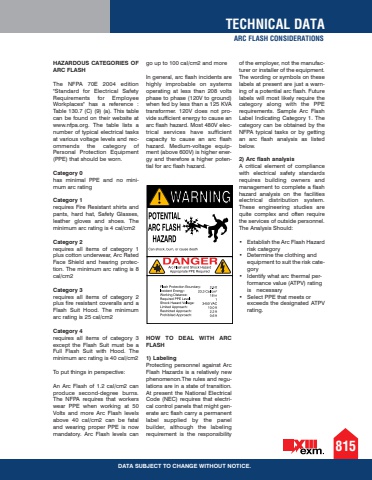Page 847 - Demo
P. 847
815TECHNICAL DATADATA SUBJECT TO CHANGE WITHOUT NOTICE.HAZARDOUS CATEGORIES OF ARC FLASHThe NFPA 70E 2004 edition \ for Electrical Safety Requirements for Employee Workplaces\Table 130.7 (C) (9) (a). This table can be found on their website at www.nfpa.org. The table lists a number of typical electrical tasks at various voltage levels and recommends the category of Personal Protection Equipment (PPE) that should be worn. Category 0 has minimal PPE and no minimum arc rating Category 1 requires Fire Resistant shirts and pants, hard hat, Safety Glasses, leather gloves and shoes. The minimum arc rating is 4 cal/cm2 Category 2 requires all items of category 1 plus cotton underwear, Arc Rated Face Shield and hearing protection. The minimum arc rating is 8 cal/cm2 Category 3 requires all items of category 2 plus fire resistant coveralls and a Flash Suit Hood. The minimum arc rating is 25 cal/cm2 Category 4 requires all items of category 3 except the Flash Suit must be a Full Flash Suit with Hood. The minimum arc rating is 40 cal/cm2 To put things in perspective: An Arc Flash of 1.2 cal/cm2 can produce second-degree burns. The NFPA requires that workers wear PPE when working at 50 Volts and more Arc Flash levels above 40 cal/cm2 can be fatal and wearing proper PPE is now mandatory. Arc Flash levels can go up to 100 cal/cm2 and more In general, arc flash incidents are highly improbable on systems operating at less than 208 volts phase to phase (120V to ground) when fed by less than a 125 KVA transformer. 120V does not provide sufficient energy to cause an arc flash hazard. Most 480V electrical services have sufficient capacity to cause an arc flash hazard. Medium-voltage equipment (above 600V) is higher energy and therefore a higher potential for arc flash hazard. HOW TO DEAL WITH ARC FLASH1) LabelingProtecting personnel against Arc Flash Hazards is a relatively new phenomenon.The rules and regulations are in a state of transition. At present the National Electrical Code (NEC) requires that electrical control panels that might generate arc flash carry a permanent label supplied by the panel builder, although the labeling requirement is the responsibility of the employer, not the manufacturer or installer of the equipment. The wording or symbols on these labels at present are just a warning of a potential arc flash. Future labels will most likely require the category along with the PPE requirements. Sample Arc Flash Label Indicating Category 1. The category can be obtained by the NFPA typical tasks or by getting an arc flash analysis as listed below. 2) Arc flash analysisA critical element of compliance with electrical safety standards requires building owners and management to complete a flash hazard analysis on the facilities electrical distribution system. These engineering studies are quite complex and often require the services of outside personnel. The Analysis Should: %u2022 Establish the Arc Flash Hazard risk category %u2022 Determine the clothing and equipment to suit the risk category %u2022 Identify what arc thermal performance value (ATPV) rating is necessary %u2022 Select PPE that meets or exceeds the designated ATPV rating. ARC FLASH CONSIDERATIONS


